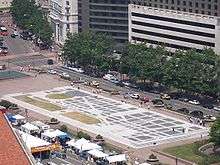Freedom Plaza

Freedom Plaza, originally known as Western Plaza, is an open plaza in Northwest Washington, D.C., United States, located at the corner of 14th Street and Pennsylvania Avenue NW, adjacent to Pershing Park. Designed by Robert Venturi, the plaza was constructed in 1980 and is mostly composed of stone, inlaid with a partial depiction of Pierre (Peter) Charles L'Enfant's plan for the City of Washington.[1][2][3] Most of the plaza is raised above street level. The western end of the plaza contains a large fountain, while the eastern end of the plaza contains an equestrian statue of Kazimierz Pułaski. The Freedom Plaza is also home to a monument honoring the Great Seal of the United States.
The plaza is one block south of the "Freedom Plaza" historical marker at stop number W.7 of the Civil War to Civil Rights Downtown Heritage Trail at 13th and E Streets, NW.[2][3]
The plaza was renamed in honor of Martin Luther King, Jr., who worked on his "I Have a Dream" speech in the nearby Willard Hotel. In 1988, a time capsule containing a Bible, a robe, and other relics of King's was planted at the site. It will be reopened in 2088.[4]
The John A. Wilson Building, the seat of the District of Columbia government, faces the plaza, as does the historic National Theatre, which has been visited by every U.S. President since it opened in 1835.[2][3] Three large hotels are to the north and west.
Freedom Plaza is a popular place for political protests and civic events. In May 1968, it was home to a shanty town known as "Resurrection City" erected by protesters affiliated with Martin Luther King, Jr.'s Poor People's Campaign, although this protest, in the wake of King's assassination, ultimately proved unsuccessful and the inhabitants of the tent city were dispersed by June of the same year.
Freedom Plaza is also one of the settings in Dan Brown's 2009 novel The Lost Symbol,[5][6] in part because of the Plaza's location at the intersection of Metro lines. The Federal Triangle Metro station, which sits on the Blue, Orange, and Silver Lines is across Pennsylvania Avenue from the plaza. The Metro Center station on the Red, Blue, Orange, and Silver lines is two blocks north on 13th Street.
Historical Commemorations
The Great Seal
The Freedom Plaza honors the Great Seal of the United States with a commemorative plaque and an inscription reading:
IN 1776 THE CONTINENTAL CONGRESS ADOPTED A RESOLUTION CALLING FOR THE CREATION OF A SEAL FOR THE NEW NATION. IN JUNE 1782 THE UNITED STATES CONGRESS APPROVED A DESIGN WHICH WAS MANUFACTURED IN SEPTEMBER OF THAT YEAR. IN EARLY 1881 THE DEPARTMENT OF STATE SELECTED A NEW DESIGN FOR THE OBVERSE, WHICH WAS MADE IN 1885. 2,000 TO 3,000 TIMES A YEAR THE SEAL IS USED ON TREATIES AND OTHER INTERNATIONAL AGREEMENTS; PROCLAMATIONS; AND COMMISSIONS OF AMBASSADORS, FOREIGN SERVICE OFFICERS, AND ALL OTHER CIVIL OFFICERS APPOINTED BY THE PRESIDENT. IN ADDITION WE SEE THE SEAL DESIGN EVERY DAY ON THE BACK OF THE ONE DOLLAR BILL.
This inscription honors both the history, and the modern functionality of the Great Seal, especially in regards to its use by the Department of State.
Assessment
The American Planning Association noted in fall 2014 that Freedom Plaza is a popular location for political protests.[7] But the Washington Business Journal newspaper called the space ill-planned.[7]
References
| Wikimedia Commons has media related to Freedom Plaza. |
- ↑ Miller, Richard E. (2009-04-13). "Western Plaza, Pennsylvania Avenue (Freedom Plaza) Marker". Historical Marker Database. Retrieved 2011-03-21.
- 1 2 3 Miller, Richard E. (2009-04-14). "Freedom Plaza Marker". Historical Marker Database. Retrieved 2011-03-21.
- 1 2 3 Busch, Richard T.; Smith, Kathryn Schneider, "W.7: Freedom Plaza: 13th and E Sts NW", Civil War to Civil Rights Downtown Heritage Trail (PDF), Washington, DC: Cultural Tourism DC, retrieved 2010-10-22 External link in
|publisher=(help) - ↑ "King's Nobel Speech Put In Time Capsule", Michael Kilian, Chicago Tribune, 1988-01-15, Chicago Tribune - Chicago, Ill.
- ↑ Ray, Rachel (2009-09-29). "Dan Brown's The Lost Symbol and Washington DC". Daily Telegraph. Retrieved 2009-10-02.
- ↑ "The Lost Symbol". washington.org. Retrieved 2009-10-02.
- 1 2 Neibauer, Michael (October 1, 2014). "Pennsylvania Avenue Is A 'Great Street' Indeed, and In Need". Washington Business Journal. Retrieved October 1, 2014.
Coordinates: 38°53′45″N 77°1′50.6″W / 38.89583°N 77.030722°W